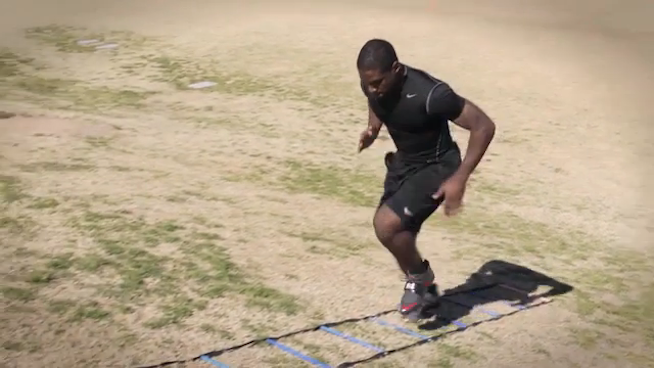King of the Hill: 5 Hill Run Exercises to Supercharge Your Speed
The weather’s heating up and you’re no longer confined to training in a dank, dark weight room or a musty indoor track. One great way to take advantage of the sunny days of summer and integrate the outdoors into your training is with hill workouts. Training on a hill dramatically kicks up the intensity of your workout and can do wonders for your speed, acceleration, endurance and lower-body strength.
We’ve seen a huge number of athletes use hills in their training, including Misty May-Treanor, Jerry Rice and the San Antonio Spurs. If you want to take your game to the next level, try these five exercises the next time you head out for some hill-based training.
Note: If you’re performing these drills on a grass hill, we suggest you wear cleats.
Uphill Sprints
Uphill Sprints are probably the most common hill-based exercise for athletes. They’re simple but super effective, because they force you to shorten your stride and increase your leg drive to ascend the hill.
Essentially, Uphill Sprints are resisted runs. The hill increases the difficulty, forcing you to make changes in your running form that will ultimately make you a faster and more explosive athlete. Uphill Sprints also require you to drive your feet into the ground behind you to propel yourself forward, which helps build proper running technique.
How-To:
- Start in a two-point stance.
- Drive out of your stance and sprint up the hill as fast as possible.
- Sprint a distance of roughly 20-30 yards on each rep.
- Slowly walk back down the hill between reps.
- Perform for 6-8 reps with 45-60 seconds of rest between.
Downhill Runs
You might think running up a hill is the best way to train, but running down a hill has awesome benefits, too. They are an example of what’s known as over-speed training, which is the opposite of resistance training. Downhill Runs let you run faster than normal while expending less energy.
This has a large number of benefits. Your muscles elongate to help you control your speed, and your body gets used to proper running technique at maximum velocity, which ultimately helps you run faster. It’s important to know which hills are fit for Downhill Runs. Look for a hill with a slight incline—somewhere around 5 or 10 degrees. Anything steeper and you’ll be risking serious injury.
How-To:
- Start in a two-point stance.
- Drive out of your stance to begin your descent.
- Don’t fight the force of gravity—embrace it.
- As your speed increases, use your arms for balance. Let your elbows swing farther away from your body if need be; your arms need to counteract the speed of your lower body.
- Maintain a slight forward lean and use short, quick strides to keep your feet underneath you.
- Land on your forefoot, not your heel. A common mistake on downhill running is to land heel first, slowing you down and enforcing bad habits.
- Run a distance of roughly 20-30 yards each rep.
- Slowly walk back up the hill between reps.
- Perform for 4-6 reps with 45-60 seconds of rest between.
Uphill Speed Ladders
Performing the same old speed ladder drills day after day can turn your training stale. Placing a speed ladder on an uphill incline adds a fun, challenging twist to your workout and simultaneously improves your footwork, coordination and lower-body strength. All-Pro cornerback Patrick Peterson loves to spice up ladder workouts by performing them on a moderate incline.
How-To:
- Find a hill with a slight to moderate incline.
- Perform your speed ladder drill as you would normally, progressing up the hill.
- Once you’ve stepped through the final rung, immediately sprint 5 yards.
- Walk back down to the start of the ladder and repeat as necessary.
- Feel free to include a wide number of speed ladder variations.
Uphill Backpedals
If backpedaling isn’t hard enough on its own, backpedaling up a hill provides a uniquely difficult challenge. Uphill Backpedals will torch your lower half and help you improve your coordination and strength. If you’re a defensive back, Uphill Backpedals are a phenomenal exercise for training a common movement and enforcing good backpedal technique.
How-To:
- Start facing away from the bottom of the hill.
- Begin your backpedal up the hill, focusing on leaning forward and keeping your chest over your thighs.
- Use short, quick steps to propel yourself backwards.
- Focus on staying low as you make your way up the hill.
- Run a distance of 10-20 yards for each rep.
- Walk back down the hill.
- Perform for 6-8 reps with 45-60 seconds of rest between.
Uphill Zigzag Drill
Your flat terrain speed training doesn’t just consist of straight-line running, so why should your hill training? The Uphill Zigzag Drill is a simple speed drill that works on multidirectional movement and explosiveness coming out of your cuts. By adding an agility element to your hill training, you ensure that both your straight-line speed and your ability to change direction will improve.
How-To:
- Placing the first cone slightly above the bottom of the hill, set up five to seven cones 5 yards apart in a zigzag pattern ascending the hill.
- Start at the first cone in a two-point stance.
- Sprint to the second cone.
- Breakdown and cut around the second cone to sprint to the next cone, keeping your hips low and your feet underneath you.
- Repeat for entire pattern, sprinting out for an additional 5 yards after you reach the final cone.
- Perform for 4 reps with 60 seconds of rest in between.
RECOMMENDED FOR YOU
King of the Hill: 5 Hill Run Exercises to Supercharge Your Speed
The weather’s heating up and you’re no longer confined to training in a dank, dark weight room or a musty indoor track. One great way to take advantage of the sunny days of summer and integrate the outdoors into your training is with hill workouts. Training on a hill dramatically kicks up the intensity of your workout and can do wonders for your speed, acceleration, endurance and lower-body strength.
We’ve seen a huge number of athletes use hills in their training, including Misty May-Treanor, Jerry Rice and the San Antonio Spurs. If you want to take your game to the next level, try these five exercises the next time you head out for some hill-based training.
Note: If you’re performing these drills on a grass hill, we suggest you wear cleats.
Uphill Sprints
Uphill Sprints are probably the most common hill-based exercise for athletes. They’re simple but super effective, because they force you to shorten your stride and increase your leg drive to ascend the hill.
Essentially, Uphill Sprints are resisted runs. The hill increases the difficulty, forcing you to make changes in your running form that will ultimately make you a faster and more explosive athlete. Uphill Sprints also require you to drive your feet into the ground behind you to propel yourself forward, which helps build proper running technique.
How-To:
- Start in a two-point stance.
- Drive out of your stance and sprint up the hill as fast as possible.
- Sprint a distance of roughly 20-30 yards on each rep.
- Slowly walk back down the hill between reps.
- Perform for 6-8 reps with 45-60 seconds of rest between.
Downhill Runs
You might think running up a hill is the best way to train, but running down a hill has awesome benefits, too. They are an example of what’s known as over-speed training, which is the opposite of resistance training. Downhill Runs let you run faster than normal while expending less energy.
This has a large number of benefits. Your muscles elongate to help you control your speed, and your body gets used to proper running technique at maximum velocity, which ultimately helps you run faster. It’s important to know which hills are fit for Downhill Runs. Look for a hill with a slight incline—somewhere around 5 or 10 degrees. Anything steeper and you’ll be risking serious injury.
How-To:
- Start in a two-point stance.
- Drive out of your stance to begin your descent.
- Don’t fight the force of gravity—embrace it.
- As your speed increases, use your arms for balance. Let your elbows swing farther away from your body if need be; your arms need to counteract the speed of your lower body.
- Maintain a slight forward lean and use short, quick strides to keep your feet underneath you.
- Land on your forefoot, not your heel. A common mistake on downhill running is to land heel first, slowing you down and enforcing bad habits.
- Run a distance of roughly 20-30 yards each rep.
- Slowly walk back up the hill between reps.
- Perform for 4-6 reps with 45-60 seconds of rest between.
Uphill Speed Ladders
Performing the same old speed ladder drills day after day can turn your training stale. Placing a speed ladder on an uphill incline adds a fun, challenging twist to your workout and simultaneously improves your footwork, coordination and lower-body strength. All-Pro cornerback Patrick Peterson loves to spice up ladder workouts by performing them on a moderate incline.
How-To:
- Find a hill with a slight to moderate incline.
- Perform your speed ladder drill as you would normally, progressing up the hill.
- Once you’ve stepped through the final rung, immediately sprint 5 yards.
- Walk back down to the start of the ladder and repeat as necessary.
- Feel free to include a wide number of speed ladder variations.
Uphill Backpedals
If backpedaling isn’t hard enough on its own, backpedaling up a hill provides a uniquely difficult challenge. Uphill Backpedals will torch your lower half and help you improve your coordination and strength. If you’re a defensive back, Uphill Backpedals are a phenomenal exercise for training a common movement and enforcing good backpedal technique.
How-To:
- Start facing away from the bottom of the hill.
- Begin your backpedal up the hill, focusing on leaning forward and keeping your chest over your thighs.
- Use short, quick steps to propel yourself backwards.
- Focus on staying low as you make your way up the hill.
- Run a distance of 10-20 yards for each rep.
- Walk back down the hill.
- Perform for 6-8 reps with 45-60 seconds of rest between.
Uphill Zigzag Drill
Your flat terrain speed training doesn’t just consist of straight-line running, so why should your hill training? The Uphill Zigzag Drill is a simple speed drill that works on multidirectional movement and explosiveness coming out of your cuts. By adding an agility element to your hill training, you ensure that both your straight-line speed and your ability to change direction will improve.
How-To:
- Placing the first cone slightly above the bottom of the hill, set up five to seven cones 5 yards apart in a zigzag pattern ascending the hill.
- Start at the first cone in a two-point stance.
- Sprint to the second cone.
- Breakdown and cut around the second cone to sprint to the next cone, keeping your hips low and your feet underneath you.
- Repeat for entire pattern, sprinting out for an additional 5 yards after you reach the final cone.
- Perform for 4 reps with 60 seconds of rest in between.















